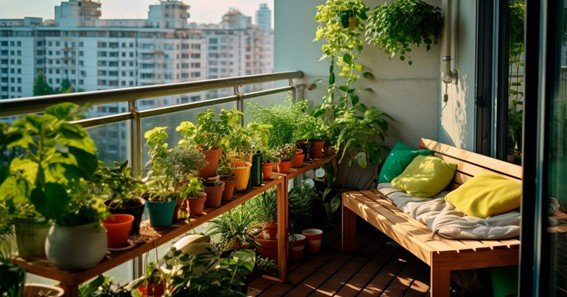Urban living comes with challenges, especially when it comes to greenery. Limited space and crowded cityscapes can make gardening feel impossible. But balcony gardens are changing that, helping city dwellers reconnect with nature. This guide will show you how to turn your balcony into a lush urban oasis, step-by-step.
Assessing Your Balcony Space
Before picking out plants or containers, take a moment to understand your balcony’s unique characteristics.
Size
Start by measuring your available space. Knowing your balcony’s exact dimensions will help you decide how large your garden can be. For compact balconies, opt for vertical gardening solutions like tiered planters or wall-mounted plant shelves to maximize space.
Sunlight
The amount of sunlight your balcony gets will heavily influence your plant selection. South-facing balconies in the northern hemisphere typically get the most light, while north-facing ones receive less. Spend a few days observing how sunlight shifts throughout the day.
Weight Limits
One crucial but often overlooked factor is the weight your balcony can support. Check with your building management or landlord to understand these limits. Containers filled with soil, water, and plants can add significant weight. Use lightweight materials when possible.
Choosing the Right Containers
The right containers are essential for plant health and aesthetics. Here’s what to keep in mind.
Materials
Containers come in materials like plastic, ceramic, metal, and terracotta. Plastic is lightweight and budget-friendly but may not offer as much insulation. Terracotta, while stylish, is heavier and more porous. Pick materials that suit both your climate and your design goals.
Drainage
Proper drainage is crucial to prevent root rot. Look for containers with drainage holes, and place saucers underneath to catch excess water.
Aesthetics
Your containers should complement your overall garden theme. Neutral tones like beige or gray create a minimalist look, while colorful pots can add a fun pop of vibrancy.
Selecting Plants
Choosing the right plants is the heart of any balcony garden. Focus on plants that thrive in your specific conditions.
Best Plants for Balconies
- Sun-Loving Plants: Herbs like basil and thyme, flowering plants like marigolds, and succulents are great for sunny balconies.
- Shade-Tolerant Plants: Grow ferns, peace lilies, and begonias for low-light spaces.
- Edibles: Tomatoes, lettuce, and strawberries are compact and ideal for balconies.
Space Considerations
For smaller balconies, prioritize compact plants. Use hanging pots or wall-mounted planters to save ground space. Combine plants with similar sunlight and watering needs for ease of maintenance.
Soil and Watering
Proper soil and watering practices form the foundation of a thriving balcony garden.
Choosing the Right Soil Mix
Invest in high-quality, lightweight potting mix instead of regular garden soil. Potting mix offers better drainage and is less likely to compact, helping plants grow healthy roots. Some mixes come pre-enriched with fertilizers, further boosting plant health.
Watering Techniques
Balconies are exposed to wind and sunlight, meaning plants dry out faster than in-ground gardens. Stick to consistent watering schedules and consider self-watering pots, especially during warm summer months.
Design and Layout
An aesthetically pleasing balcony garden adds joy to your space.
Layer Your Space
Add height and dimension by layering plants. Use tall planters at the back, medium-sized ones in the middle, and smaller pots at the front. This creates a lush, layered effect without feeling cluttered.
Add Decor
String fairy lights, incorporate a small outdoor rug, or place a table and chair to turn your balcony into a cozy retreat. Add materials like bamboo trellises or ferrous wires for hanging pots and wall displays, adding both beauty and functionality.
Maintenance
Consistency is key to keeping your garden vibrant and healthy.
Fertilizing
Balcony plants drain nutrients from their pots quickly. Apply fertilizers every few weeks to replenish the soil. Choose organic options if you’re growing edible plants.
Pruning
Regular pruning keeps your plants healthy and prevents overcrowding. Dead leaves and flowers can harbor pests, so trim them frequently.
Pest Control
Monitor your garden for pests like aphids or spider mites. Use neem oil or organic insecticides to keep infestations under control.
Seasonal Adjustments
Gardens, like nature, change with the seasons.
- Spring & Summer: Focus on fast-growing plants and colorful blooms. Increase watering as temperatures rise.
- Fall: Add hardy perennials, and use mulch to protect the soil.
- Winter: Consider moving sensitive plants indoors if temperatures drop significantly. Protect outdoor pots with insulation.
Conclusion
Congratulations! With a little time and care, you’ll have a personal balcony garden that lets you escape the urban hustle and bustle, one plant at a time. A well-curated urban garden isn’t just for looks; it’s a haven, a source of fresh produce, and a way to reconnect with nature. Happy gardening!








